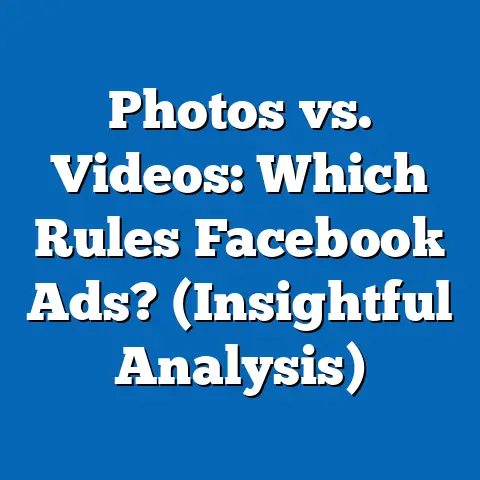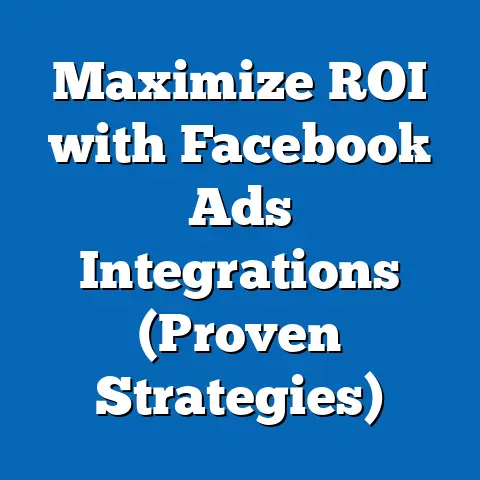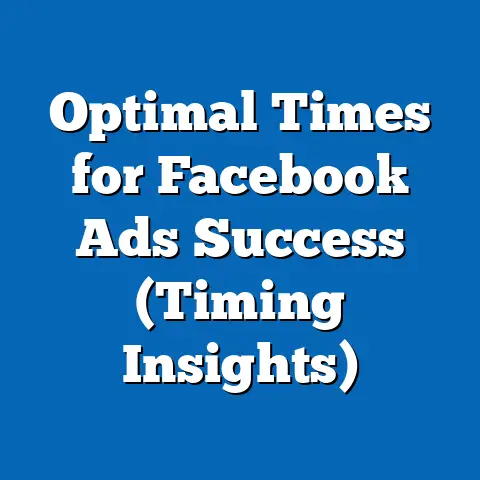Master Attribution Settings in Facebook Ads (Unlock Campaign Success)
I’ve seen it happen time and again: businesses pour money into Facebook ads, hoping for a tidal wave of conversions, only to be met with a trickle – or worse, a complete drought. What’s often the culprit? Misunderstood or neglected attribution settings. In the complex world of digital advertising, attribution is the compass that guides your budget, steers your strategy, and ultimately, determines whether you reach your destination of campaign success.
Imagine two scenarios:
-
Scenario 1: Attribution Mastery. A local bakery, “Sweet Surrender,” starts running Facebook ads to promote its new line of gluten-free pastries. They meticulously set up their attribution settings, tracking conversions across devices and understanding the customer journey. They discover that many customers initially see their ads on mobile but convert later on their desktop after browsing the menu. With this knowledge, they optimize their ads for mobile viewing and ensure their website is mobile-friendly, resulting in a 40% increase in online orders.
-
Scenario 2: Attribution Blindness. A tech startup, “InnovateNow,” launches a Facebook ad campaign for its new project management software. They skip over the attribution settings, assuming Facebook will figure it out. They see a decent number of clicks but very few conversions. Confused, they pull the plug on the campaign, thinking Facebook ads don’t work for them. They missed the crucial insight that their target audience often clicks on ads during their commute (mobile) but signs up for a free trial at their office (desktop).
Scenario 1: Attribution Mastery. A local bakery, “Sweet Surrender,” starts running Facebook ads to promote its new line of gluten-free pastries. They meticulously set up their attribution settings, tracking conversions across devices and understanding the customer journey. They discover that many customers initially see their ads on mobile but convert later on their desktop after browsing the menu. With this knowledge, they optimize their ads for mobile viewing and ensure their website is mobile-friendly, resulting in a 40% increase in online orders.
Scenario 2: Attribution Blindness. A tech startup, “InnovateNow,” launches a Facebook ad campaign for its new project management software. They skip over the attribution settings, assuming Facebook will figure it out. They see a decent number of clicks but very few conversions. Confused, they pull the plug on the campaign, thinking Facebook ads don’t work for them. They missed the crucial insight that their target audience often clicks on ads during their commute (mobile) but signs up for a free trial at their office (desktop).
1. Understanding Attribution: The Foundation of Facebook Ads
Attribution, in the simplest terms, is the process of identifying which marketing touchpoints deserve credit for a desired outcome, like a sale, a lead, or a website visit. In the context of Facebook ads, attribution helps you understand which ads, ad sets, and campaigns are driving the most valuable actions. It’s not just about knowing you got a conversion; it’s about knowing how you got that conversion.
Why is Attribution Important?
Think of attribution as the GPS for your advertising budget. Without it, you’re driving blind, potentially wasting money on ads that don’t contribute to your goals. Here’s why attribution is so crucial:
- Accurate ROI Measurement: Attribution allows you to accurately measure the return on investment (ROI) of your Facebook ad campaigns. By understanding which ads are driving conversions, you can allocate your budget to the most effective strategies.
- Optimized Budget Allocation: Knowing which touchpoints are contributing to conversions allows you to shift your budget towards those channels, improving overall campaign performance.
- Improved Targeting: Attribution data can reveal insights into your audience’s behavior, helping you refine your targeting strategies and reach more qualified leads.
- Enhanced Customer Journey Understanding: Attribution provides a clearer picture of the customer journey, showing you how users interact with your ads across different devices and channels before converting.
- Data-Driven Decision Making: Attribution empowers you to make informed decisions based on real data, rather than relying on guesswork or gut feelings.
Different Attribution Models: Choosing the Right Fit
Facebook offers several attribution models, each assigning credit to different touchpoints in the customer journey. Understanding these models is crucial for selecting the one that best aligns with your business goals. Here’s a breakdown of the most common models:
- Last-Click Attribution: This model gives 100% of the credit to the last ad clicked before the conversion. It’s the simplest model to understand but often overlooks the influence of earlier touchpoints.
- Example: A user sees your ad, doesn’t click. Sees another ad a week later, clicks, and buys something. Last-click gives ALL the credit to the second ad.
- First-Click Attribution: This model assigns 100% of the credit to the first ad clicked in the customer journey. It’s useful for understanding which ads are most effective at initiating the sales process.
- Example: Same scenario as above, but the FIRST ad now gets ALL the credit.
- Linear Attribution: This model distributes credit evenly across all touchpoints in the customer journey. It acknowledges the contribution of each interaction but doesn’t prioritize any specific touchpoint.
- Example: Both ads get 50% of the credit.
- Time-Decay Attribution: This model gives more credit to touchpoints that occur closer to the conversion. It recognizes that recent interactions have a stronger influence on the final decision.
- Example: The second ad gets significantly more credit (e.g., 80%) because it was closer to the purchase.
- Position-Based Attribution (U-Shaped): This model assigns a significant portion of the credit to the first and last touchpoints, with the remaining credit distributed among the other interactions. It acknowledges the importance of both initial awareness and final conversion.
- Example: The first and second ads each get a large chunk of the credit (e.g., 40% each), with the remaining 20% distributed among any other touchpoints.
- Example: A user sees your ad, doesn’t click. Sees another ad a week later, clicks, and buys something. Last-click gives ALL the credit to the second ad.
- Example: Same scenario as above, but the FIRST ad now gets ALL the credit.
- Example: Both ads get 50% of the credit.
- Example: The second ad gets significantly more credit (e.g., 80%) because it was closer to the purchase.
- Example: The first and second ads each get a large chunk of the credit (e.g., 40% each), with the remaining 20% distributed among any other touchpoints.
Choosing the Right Model: There is no one-size-fits-all attribution model. The best choice depends on your business goals, the length of your sales cycle, and the complexity of your customer journey. For example:
- E-commerce with Short Sales Cycle: Last-click or time-decay might be suitable.
- High-Value Products with Long Sales Cycle: Linear or position-based might be better.
- Focus on Brand Awareness: First-click might be useful for understanding initial engagement.
Takeaway: Attribution is the bedrock of effective Facebook advertising. Understanding different models and choosing the right one is crucial for measuring ROI, optimizing budget allocation, and improving targeting.
Next Steps: Take some time to think about your business, your sales cycle, and your specific goals. Which attribution model seems like the best fit?
2. The Importance of Attribution Settings in Facebook Ads
Attribution settings are more than just a technicality; they are the lens through which you view your campaign performance. The settings you choose directly influence the data you see in your reports, which, in turn, affects the decisions you make about your ads.
How Attribution Settings Affect Ad Performance Insights
Imagine you’re running a campaign to generate leads for your SaaS product. You’re using a last-click attribution model. You notice that one ad set, targeting a specific industry, seems to be performing exceptionally well, generating a high number of leads. Based on this information, you decide to increase the budget for that ad set.
However, what if those leads are actually the result of earlier interactions with a different ad set that focused on broader brand awareness? By using a last-click model, you’re only seeing the final touchpoint and missing the crucial role that the initial ad set played in nurturing those leads.
The right attribution settings provide a more complete and accurate picture of your campaign performance, allowing you to:
- Identify the Most Effective Ads: See which ads are truly driving conversions, even if they’re not the last touchpoint in the customer journey.
- Optimize Your Ad Creative: Understand which ad creatives resonate most with your audience and lead to conversions.
- Refine Your Targeting: Identify which audience segments are most likely to convert based on their interactions with your ads.
- Improve Your Customer Journey: See how users interact with your ads across different devices and channels before converting, allowing you to optimize the entire experience.
- Make Informed Budget Decisions: Allocate your budget to the strategies that are truly driving results, rather than relying on incomplete or misleading data.
Real-World Examples: Attribution in Action
Let’s look at some real-world examples to illustrate the impact of correct attribution settings:
-
Example 1: E-commerce Fashion Brand. A fashion brand ran a Facebook ad campaign to promote its new summer collection. Initially, they used a last-click attribution model and saw that ads featuring specific product images were performing best. However, after switching to a position-based model, they discovered that ads showcasing lifestyle images and brand storytelling were actually driving the initial interest and awareness that led to those product-specific conversions. They adjusted their strategy to prioritize lifestyle ads, resulting in a 25% increase in overall sales.
-
Example 2: Lead Generation for a Consulting Firm. A consulting firm ran a Facebook ad campaign to generate leads for its services. They used a linear attribution model and saw that all their ads were performing relatively equally. However, after analyzing their attribution data more closely, they realized that users who clicked on ads featuring case studies were much more likely to convert into high-value clients. They refined their strategy to focus on case study ads, resulting in a 30% increase in the quality of their leads.
Example 1: E-commerce Fashion Brand. A fashion brand ran a Facebook ad campaign to promote its new summer collection. Initially, they used a last-click attribution model and saw that ads featuring specific product images were performing best. However, after switching to a position-based model, they discovered that ads showcasing lifestyle images and brand storytelling were actually driving the initial interest and awareness that led to those product-specific conversions. They adjusted their strategy to prioritize lifestyle ads, resulting in a 25% increase in overall sales.
Example 2: Lead Generation for a Consulting Firm. A consulting firm ran a Facebook ad campaign to generate leads for its services. They used a linear attribution model and saw that all their ads were performing relatively equally. However, after analyzing their attribution data more closely, they realized that users who clicked on ads featuring case studies were much more likely to convert into high-value clients. They refined their strategy to focus on case study ads, resulting in a 30% increase in the quality of their leads.
The Cost of Inaccurate Attribution
Inaccurate attribution settings can lead to significant losses for advertisers. Here are some potential consequences:
- Wasted Ad Spend: You may be allocating your budget to ads that don’t contribute to your goals, wasting valuable resources.
- Missed Opportunities: You may be overlooking high-performing ads or strategies, missing out on potential conversions.
- Inaccurate Reporting: You may be making decisions based on incomplete or misleading data, leading to poor campaign performance.
- Lower ROI: Ultimately, inaccurate attribution settings can result in a lower return on investment for your Facebook ad campaigns.
Takeaway: Attribution settings are not just a technical detail; they are the foundation of effective Facebook advertising. Choosing the right settings provides a more complete and accurate picture of your campaign performance, allowing you to make informed decisions and maximize your ROI.
Next Steps: Review your current Facebook ad campaigns and consider whether your attribution settings are accurately reflecting the customer journey. Are you potentially missing out on valuable insights?
3. Overview of Facebook’s Attribution Tool
Facebook’s Attribution tool is a powerful platform designed to help you understand the impact of your marketing efforts across various channels, including Facebook, Instagram, and even offline conversions. It allows you to track the customer journey from initial ad exposure to final conversion, providing valuable insights into which touchpoints are driving the most valuable actions.
Accessing the Attribution Tool
You can access the Facebook Attribution tool directly from your Facebook Ads Manager. Here’s how:
- Go to Facebook Ads Manager: Navigate to your Facebook Ads Manager account.
- Click on “All Tools”: In the left-hand menu, click on “All Tools.”
- Select “Attribution”: Under the “Measure & Report” section, select “Attribution.”
Key Features and Functionalities
Facebook’s Attribution tool offers a range of features and functionalities to help you understand your marketing performance:
- Cross-Device Tracking: Track conversions across different devices, such as mobile phones, tablets, and desktops. This is crucial for understanding the full customer journey, as users often interact with your ads on multiple devices before converting.
- Conversion Path Analysis: See the sequence of interactions that lead to a conversion. This allows you to identify the most important touchpoints in the customer journey and optimize your marketing efforts accordingly.
- Attribution Modeling: Choose from various attribution models, such as last-click, first-click, linear, time-decay, and position-based, to assign credit to different touchpoints in the customer journey.
- Customizable Reports: Create custom reports to track specific metrics and analyze your data in a way that’s relevant to your business goals.
- Integration with Facebook Pixel and SDK: The Attribution tool seamlessly integrates with the Facebook Pixel and SDK, allowing you to track website and app conversions accurately.
- Offline Conversion Tracking: Track conversions that occur offline, such as in-store purchases or phone calls, by uploading data from your CRM or other systems.
- Multi-Channel Attribution: While primarily focused on Facebook and Instagram, the tool can also integrate with other marketing channels to provide a more holistic view of your marketing performance.
Data Available Through the Attribution Tool
The Facebook Attribution tool provides a wealth of data to help you understand your marketing performance:
- Conversion Value: The total value of conversions attributed to your marketing efforts.
- Cost Per Conversion: The cost of acquiring each conversion.
- Return on Ad Spend (ROAS): The revenue generated for every dollar spent on advertising.
- Attribution Touchpoints: The specific ads, ad sets, and campaigns that contributed to conversions.
- Conversion Paths: The sequence of interactions that led to conversions.
- Device Breakdown: The devices used by users who converted.
- Demographic Data: The demographic characteristics of users who converted.
Integration with Facebook Pixel and SDK
The Facebook Pixel and SDK are essential for accurate data collection in the Attribution tool.
- Facebook Pixel: A snippet of code that you install on your website to track user actions, such as page views, add-to-carts, and purchases.
- Facebook SDK: A software development kit that you integrate into your mobile app to track user actions, such as app installs, in-app purchases, and custom events.
By integrating the Pixel and SDK with your website and app, you can provide the Attribution tool with the data it needs to accurately track conversions and attribute them to your marketing efforts.
Takeaway: Facebook’s Attribution tool is a powerful platform that provides valuable insights into your marketing performance. By understanding its features and functionalities, you can track the customer journey, analyze your data, and optimize your campaigns for maximum ROI.
Next Steps: Familiarize yourself with the Facebook Attribution tool by exploring its features and functionalities. Ensure that you have the Facebook Pixel and SDK properly installed on your website and app.
4. Setting Up Attribution in Facebook Ads
Setting up attribution correctly within Facebook Ads Manager is a critical step towards understanding the true impact of your campaigns. Here’s a step-by-step guide to help you navigate the process:
Step-by-Step Guide to Setting Up Attribution
-
Access Ads Manager: Log in to your Facebook Ads Manager account.
-
Navigate to Attribution: As described in the previous section, go to “All Tools” and select “Attribution” under the “Measure & Report” section.
-
Create a New Attribution Project (If Necessary): If you haven’t already, you’ll need to create a new attribution project. This involves connecting your Facebook ad account, your website, and any other relevant data sources.
-
Configure Your Attribution Settings: This is where you define how conversions will be attributed to your ads.
- Attribution Window: Choose the attribution window, which determines how far back in time you want to track interactions. Facebook typically offers options like 1-day click, 7-day click, and 28-day click, as well as view-through attribution windows (e.g., 1-day view).
- Example: A 7-day click attribution window means that if someone clicks on your ad and converts within 7 days, the conversion will be attributed to that ad.
- Attribution Model: Select the attribution model that best aligns with your business goals, as discussed earlier (last-click, first-click, linear, time-decay, or position-based).
- Conversion Events: Specify the conversion events that you want to track, such as purchases, leads, website visits, or app installs. Make sure these events are properly set up in your Facebook Pixel or SDK.
- Attribution Window: Choose the attribution window, which determines how far back in time you want to track interactions. Facebook typically offers options like 1-day click, 7-day click, and 28-day click, as well as view-through attribution windows (e.g., 1-day view).
-
Save Your Settings: Once you’ve configured your attribution settings, save them to apply them to your campaigns.
Access Ads Manager: Log in to your Facebook Ads Manager account.
Navigate to Attribution: As described in the previous section, go to “All Tools” and select “Attribution” under the “Measure & Report” section.
Create a New Attribution Project (If Necessary): If you haven’t already, you’ll need to create a new attribution project. This involves connecting your Facebook ad account, your website, and any other relevant data sources.
Configure Your Attribution Settings: This is where you define how conversions will be attributed to your ads.
- Attribution Window: Choose the attribution window, which determines how far back in time you want to track interactions. Facebook typically offers options like 1-day click, 7-day click, and 28-day click, as well as view-through attribution windows (e.g., 1-day view).
- Example: A 7-day click attribution window means that if someone clicks on your ad and converts within 7 days, the conversion will be attributed to that ad.
- Attribution Model: Select the attribution model that best aligns with your business goals, as discussed earlier (last-click, first-click, linear, time-decay, or position-based).
- Conversion Events: Specify the conversion events that you want to track, such as purchases, leads, website visits, or app installs. Make sure these events are properly set up in your Facebook Pixel or SDK.
- Example: A 7-day click attribution window means that if someone clicks on your ad and converts within 7 days, the conversion will be attributed to that ad.
Save Your Settings: Once you’ve configured your attribution settings, save them to apply them to your campaigns.
Choosing the Right Attribution Model
Selecting the right attribution model is a crucial decision that can significantly impact your understanding of campaign performance. Consider the following factors when making your choice:
- Length of Sales Cycle: If you have a short sales cycle (e.g., e-commerce), a last-click or time-decay model may be appropriate. If you have a long sales cycle (e.g., high-value products or services), a linear or position-based model may be better.
- Marketing Goals: If your primary goal is to drive brand awareness, a first-click model may be useful. If your goal is to generate leads, a model that gives credit to all touchpoints may be more appropriate.
- Customer Journey: Consider the complexity of your customer journey. If users typically interact with your ads multiple times before converting, a model that distributes credit across all touchpoints may be more accurate.
Customizing Attribution Settings for Different Campaigns
It’s important to note that you can customize your attribution settings for different types of campaigns. For example:
- Awareness Campaigns: For campaigns focused on brand awareness, you may want to use a first-click attribution model to understand which ads are most effective at initiating the sales process.
- Consideration Campaigns: For campaigns focused on driving consideration, you may want to use a linear or position-based model to understand the impact of all touchpoints in the customer journey.
- Conversion Campaigns: For campaigns focused on driving conversions, you may want to use a last-click or time-decay model to understand which ads are most effective at closing the sale.
Tips for Optimizing Attribution Settings
Here are some additional tips for optimizing your attribution settings:
- Test Different Models: Experiment with different attribution models to see which one provides the most accurate insights into your campaign performance.
- Analyze Your Data Regularly: Regularly review your attribution data to identify trends and patterns that can inform your future campaigns.
- Stay Up-to-Date: Keep up with the latest changes and updates to Facebook’s attribution tool to ensure that you’re using the most effective settings.
- Consider Third-Party Tools: Explore third-party attribution tools that may offer more advanced features and capabilities.
Screenshot Examples:
(Imagine screenshots here showing the steps to access the Attribution tool, configure attribution settings, and select different models.)
Takeaway: Setting up attribution correctly within Facebook Ads Manager is a crucial step towards understanding the true impact of your campaigns. By carefully considering your business goals, customer journey, and marketing objectives, you can choose the right attribution model and customize your settings for maximum ROI.
Next Steps: Log in to your Facebook Ads Manager account and configure your attribution settings for your active campaigns. Experiment with different models and analyze your data regularly to identify trends and patterns.
5. Analyzing Attribution Reports: Turning Data into Action
Once you’ve set up your attribution settings, the real work begins: analyzing the reports and turning that data into actionable insights. Facebook’s Attribution tool provides a wealth of information, but it’s essential to know how to interpret it and use it to optimize your campaigns.
Reading and Interpreting Attribution Reports
Attribution reports can seem overwhelming at first, but by focusing on key metrics and understanding the relationships between them, you can gain valuable insights into your campaign performance. Here’s a breakdown of the key elements:
- Conversion Value: This metric shows the total value of conversions attributed to your marketing efforts. It’s a crucial indicator of the overall effectiveness of your campaigns.
- Cost Per Conversion (CPC): This metric shows the cost of acquiring each conversion. It’s important to track CPC to ensure that you’re not overspending on your campaigns.
- Return on Ad Spend (ROAS): This metric shows the revenue generated for every dollar spent on advertising. ROAS is a key indicator of the profitability of your campaigns.
- Attribution Touchpoints: This section of the report shows the specific ads, ad sets, and campaigns that contributed to conversions. It allows you to identify the most effective touchpoints in the customer journey.
- Conversion Paths: This section of the report shows the sequence of interactions that led to conversions. It provides valuable insights into how users interact with your ads across different devices and channels before converting.
- Device Breakdown: This section of the report shows the devices used by users who converted. It allows you to understand whether your audience is primarily using mobile phones, tablets, or desktops.
- Demographic Data: This section of the report shows the demographic characteristics of users who converted. It allows you to refine your targeting strategies and reach more qualified leads.
Key Metrics to Focus On
While all the data in the attribution reports is valuable, some metrics are more important than others. Here are the key metrics you should focus on:
- ROAS: This is the ultimate measure of campaign success. Aim for a ROAS that is significantly higher than your cost of goods sold and other expenses.
- Cost Per Conversion: Track this metric closely to ensure that you’re not overspending on your campaigns.
- Attribution Touchpoints: Identify the ads, ad sets, and campaigns that are driving the most valuable conversions.
- Conversion Paths: Understand how users are interacting with your ads before converting. Are they seeing multiple ads? Are they using different devices?
Using Reports to Inform Future Campaigns
The insights you gain from your attribution reports should be used to inform your future campaigns. Here are some ways to use the data:
- Optimize Your Budget: Allocate your budget to the ads, ad sets, and campaigns that are driving the most valuable conversions.
- Refine Your Targeting: Use demographic data to refine your targeting strategies and reach more qualified leads.
- Improve Your Ad Creative: Analyze the performance of different ad creatives to identify which ones resonate most with your audience.
- Optimize Your Customer Journey: Use conversion path data to optimize the customer journey and ensure that users have a seamless experience across all devices and channels.
- Test New Strategies: Use the data to identify new opportunities for improvement and test new strategies to optimize your campaigns.
Anecdotal Evidence and Testimonials
I’ve personally seen countless businesses transform their Facebook ad performance by leveraging attribution reports. One example that stands out is a local gym that was struggling to generate new memberships through Facebook ads. They were running various ad campaigns, but they couldn’t figure out which ones were actually driving results.
After implementing Facebook’s Attribution tool and analyzing their reports, they discovered that ads featuring testimonials from existing members were significantly more effective than ads showcasing workout equipment or promotional offers. They shifted their strategy to focus on testimonial ads, resulting in a 50% increase in new membership sign-ups.
Takeaway: Analyzing attribution reports is crucial for turning data into action. By focusing on key metrics, understanding the relationships between them, and using the data to inform your future campaigns, you can significantly improve your Facebook ad performance.
Next Steps: Take some time to analyze your attribution reports and identify opportunities for improvement. Experiment with different strategies and track your results to see what works best for your business.
6. Common Challenges and Solutions in Attribution
While Facebook’s Attribution tool is powerful, it’s not without its challenges. Marketers often encounter issues like data discrepancies, multi-channel complexities, and the ever-evolving landscape of data privacy. Let’s explore some common challenges and practical solutions.
Data Discrepancies
One of the most frustrating challenges in attribution is data discrepancies. You might see different numbers in Facebook Ads Manager, Google Analytics, and other platforms. This can be due to several factors:
- Different Attribution Models: Each platform may use a different attribution model, leading to variations in the reported data.
- Tracking Differences: The way each platform tracks conversions may differ, resulting in discrepancies in the reported numbers.
- Data Delays: There may be delays in data processing, causing inconsistencies in the reported data.
Solutions:
- Choose a Consistent Attribution Model: Try to use the same attribution model across all your platforms to minimize discrepancies.
- Understand Tracking Differences: Familiarize yourself with the specific tracking methods used by each platform and account for any differences.
- Allow for Data Delays: Be aware that there may be delays in data processing and wait for the data to stabilize before making any major decisions.
- Focus on Trends: Instead of focusing on exact numbers, look for trends and patterns in the data to identify areas for improvement.
Multi-Channel Complexities
In today’s digital landscape, customers interact with businesses across multiple channels, including Facebook, Instagram, Google, email, and even offline touchpoints. This makes it challenging to accurately attribute conversions to specific marketing efforts.
Solutions:
- Implement a Multi-Channel Attribution Solution: Consider using a third-party attribution tool that can track conversions across multiple channels and provide a more holistic view of your marketing performance.
- Integrate Your Data: Integrate your data from different marketing channels into a central platform to gain a more complete picture of the customer journey.
- Focus on Incrementality: Instead of trying to attribute every conversion to a specific touchpoint, focus on measuring the incremental impact of your marketing efforts.
The Role of Advanced Tools and Technologies
Advanced tools and technologies, such as machine learning and AI, are playing an increasingly important role in enhancing attribution accuracy. These technologies can analyze vast amounts of data to identify complex patterns and predict the impact of different marketing touchpoints.
Solutions:
- Explore AI-Powered Attribution Tools: Consider using AI-powered attribution tools that can automatically optimize your campaigns based on real-time data.
- Leverage Machine Learning Algorithms: Use machine learning algorithms to identify the most effective touchpoints in the customer journey and optimize your marketing efforts accordingly.
- Embrace Predictive Analytics: Use predictive analytics to forecast the impact of different marketing strategies and make informed decisions about your budget allocation.
Takeaway: Attribution is not without its challenges, but by understanding these challenges and implementing practical solutions, you can improve the accuracy of your data and make more informed decisions about your marketing efforts.
Next Steps: Evaluate your current attribution setup and identify any challenges you’re facing. Explore different solutions, such as implementing a multi-channel attribution solution or using AI-powered tools, to improve the accuracy of your data and optimize your campaigns.
7. Future Trends in Attribution for Facebook Ads
The world of digital advertising is constantly evolving, and attribution is no exception. As data privacy regulations become stricter and user behavior becomes more complex, the future of attribution will be shaped by several key trends.
Shifts Towards Privacy-Centric Models
With increasing concerns about data privacy, there’s a growing shift towards privacy-centric attribution models. These models aim to protect user privacy while still providing valuable insights into marketing performance.
Examples:
- Aggregated Data: Using aggregated data instead of individual user data to track conversions.
- Differential Privacy: Adding noise to the data to protect user privacy while still allowing for accurate analysis.
- Privacy-Preserving Technologies: Implementing technologies that allow for attribution without revealing individual user data.
Preparing for Changes in Attribution
Advertisers need to prepare for changes in attribution due to evolving data privacy laws and platform policies. Here are some steps you can take:
- Stay Informed: Keep up with the latest changes and updates to data privacy regulations and platform policies.
- Diversify Your Tracking Methods: Don’t rely solely on third-party cookies or other tracking methods that may be affected by privacy regulations.
- Invest in First-Party Data: Focus on collecting first-party data from your customers and using it to personalize your marketing efforts.
- Embrace Privacy-Preserving Technologies: Implement privacy-preserving technologies to protect user privacy while still allowing for accurate attribution.
The Future of Attribution Models
The future of attribution models is likely to be more sophisticated and data-driven. Here are some potential developments:
- AI-Powered Attribution: AI-powered attribution models will be able to analyze vast amounts of data to identify complex patterns and predict the impact of different marketing touchpoints.
- Customizable Attribution Models: Advertisers will be able to create custom attribution models that are tailored to their specific business goals and customer journeys.
- Real-Time Attribution: Attribution data will be available in real-time, allowing advertisers to make immediate adjustments to their campaigns based on the latest performance data.
Takeaway: The future of attribution is likely to be more privacy-centric, data-driven, and sophisticated. By staying informed about emerging trends and preparing for changes in the industry, advertisers can ensure that they’re able to accurately measure their marketing performance and optimize their campaigns for maximum ROI.
Next Steps: Research emerging trends and technologies in digital attribution. Consider how these trends may impact your current attribution setup and start planning for the future.
Conclusion: Empowering Your Facebook Ads Strategy Through Attribution Mastery
I’ve taken you through the intricate world of Facebook Ads attribution, from foundational concepts to future trends. You’ve learned about the importance of attribution, the different models available, how to set up attribution correctly, how to analyze attribution reports, and how to overcome common challenges.
Mastering attribution settings is not just about understanding the technical aspects; it’s about understanding your customers, their journey, and the impact of your marketing efforts. By taking the time to configure your attribution settings correctly and analyze your data regularly, you can unlock valuable insights that will help you optimize your campaigns, improve your ROI, and achieve your business goals.
Key Takeaways:
- Attribution is the foundation of effective Facebook advertising.
- Choosing the right attribution model is crucial for measuring ROI and optimizing budget allocation.
- Facebook’s Attribution tool provides valuable insights into your marketing performance.
- Analyzing attribution reports is essential for turning data into action.
- Advertisers need to prepare for changes in attribution due to evolving data privacy laws.
Actionable Steps:
- Review your current Facebook ad campaigns and consider whether your attribution settings are accurately reflecting the customer journey.
- Familiarize yourself with Facebook’s Attribution tool and ensure that you have the Facebook Pixel and SDK properly installed on your website and app.
- Experiment with different attribution models to see which one provides the most accurate insights into your campaign performance.
- Analyze your attribution reports regularly and use the data to inform your future campaigns.
- Stay informed about emerging trends and technologies in digital attribution.
By taking these actionable steps, you can empower your Facebook ads strategy through attribution mastery and unlock your campaign success. Remember, in the ever-evolving world of digital advertising, understanding and leveraging attribution is no longer a luxury – it’s a necessity. Don’t let your ad budget be a shot in the dark; use attribution to illuminate the path to success.






